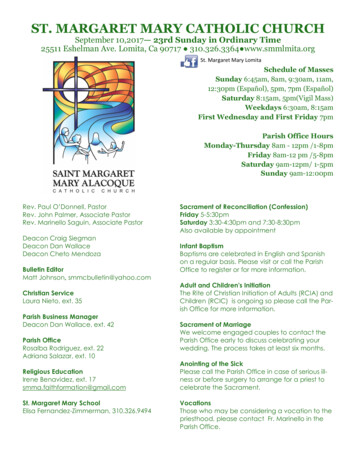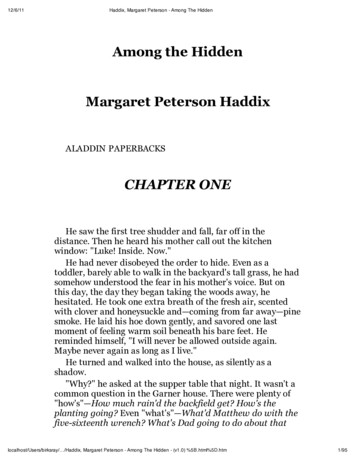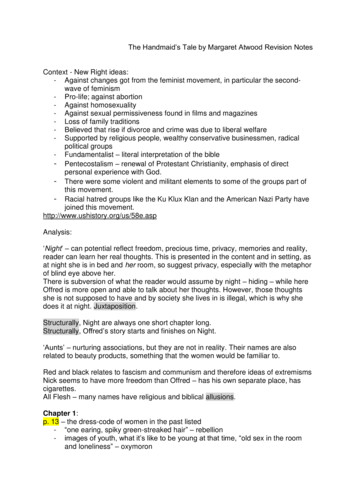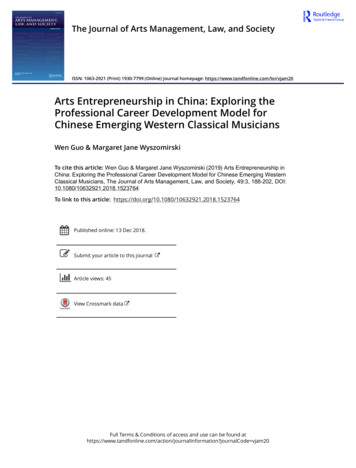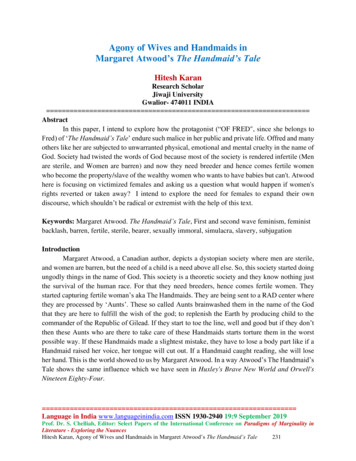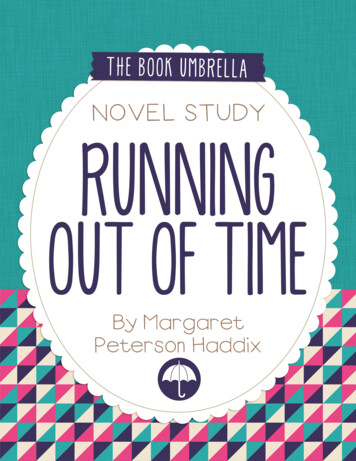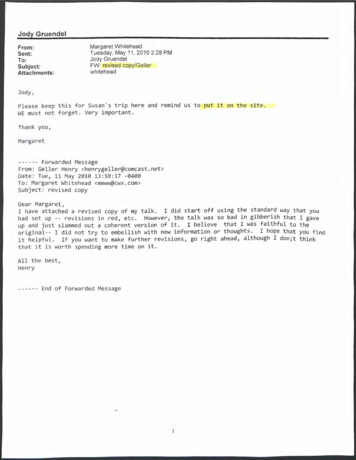
Transcription
Jody GruendelFrom:Sent:To:Subject:Attachments:Margaret WhiteheadTuesday, May 11, 2010 2:28 PMJody GruendelFW: revised copy/Gellerwhitehead3ody,Please keep this for Susan's trip here and remind us to put it on the site.WE must not forget. Very important.Thank you,MargaretForwarded MessageFrom: Geller Henry henrygeller@comcast.net Date: Tue, 11 May 2010 13:59:17 -0400To: Margaret Whitehead mmww@cwx.com Subject: revised copyDear Margaret,I have attached a revised copy of my talk. I did start off using the standard way that youhad set up -- revisions in red, etc. However, the talk was so bad in gibberish that I gaveup and just slammed out a coherent version of it. I believe that I was faithful to theoriginal-- I did not try to embellish with new information or thoughts. I hope that you findit helpful. If you want to make further revisions, go right ahead, although I don;t thinkthat it is worth spending more time on it.All the best,HenryEnd of Forwarded Message-1
IHenry Geller. There are two issues that I want to talk to you about. One is the legal orconstitutional issue, and the other is the more interesting policy issue. I hope to devotemost of my discussion to the policy issue. The only caveat is that with age the cilia in theears wear out, and so you have to speak in italics. Otherwise, I won't hear you. Sincethis is a seminar discussion, your questions do matter.The public interest standard for broadcasting was taken from a 1920 Transportation Act.There was a lot of chaos in the 1920's in the radio field. The Department of Commercedid license radio stations, but stations could and did jump to another frequency or tohigher power. The result was interference and engineering chaos. So broadcasterswanted the regulatory scheme to protect themselves. Economists like Ronald Coase andTom Hazlett argue that there was no need for this scheme of short term public interestlicensing. Yes, there is scarcity in spectrum. But there is scarcity in all kinds of things,and it was not necessary to go to this system of short - term licensing.But the government did choose this scheme in 1927. And it repeated the same regulatoryapproach in the more comprehensive 1934 Act, and again in the 1996 Telecom Actwhere the common carrier area was reformed, the public interest standard was retainedfor broadcasting and broadcasting was given new digital spectrum. The short - termlicensing standard in the beginning was just three years but in 1996 it became eight years.The broadcast station at renewal must show a federal agency, the FCC,that it has servedthe public interest.
2The public interest standard now has three explicit requirements in the Act. One is localservice. The broadcaster must serve as an outlet for discussion of local issues or localmatters. The allocation scheme devised by government requires that local service. It ispossible to serve everybody by very powerful regional stations, but that was not done.Instead, each significantly large community has its own local stations. And if so muchspectrum has been allocated to this local service, the government really ought to see thatthe people do get this local programming.The second requirement in the Act involves the fact that broadcasting is the medium mostrelied upon by people for information. That's kind of a pity, because the information inbroadcasting is not in depth but very terse. If you take the evening TV network newscastand break it out into print, it comes to two-thirds of one page of a newspaper. So peoplerelying on TV for their news are getting no in-depth information at all. This secondrequirement for broadcasting to contribute to an informed electorate is set out in the Actin sections like 315 and 312(a)(7).The third requirement came in a 1990 amendment to the Act, because children watch somuch TV. It's their window on the world. Which again is a pity. They ought to bereading rather than watching so much TV. The public interest standard requires thatthere be a significant amount of programming that not only entertains them — childrenwon't watch if they are not entertained — but also educates and informs. Theprogramming has to be specifically designed to do that.Let's now turn to the legal issue raised by this scheme. (And please interrupt withquestions at any time). The constitutional issue came up in the Pottsville case and then
3again in NBC v. FCC,319 U.S. 190 in 1943, reviewing the Chain Broadcastings rules ofthe FCC.You have to remember that there had not been full development of the Supreme Court'sFirst Amendmentjurisprudence at this time. The Court in the early 1930's invalidated aprior restraint on newspaper publication in Near v. Minnesota. But the strict scrutiny ofcontent regulation and the intermediate scrutiny of incidental impact on content inO'Brien did not surface until 1968. So in 1943 the Court simply stated that if theregulation is reasonably related to the public interest, it is constitutional and grounded itsdecision on allocation scarcity. It stated that more people want to broadcast than there areavailable channels; the government chooses one person or entity and keeps everyone elseoff the frequency. So that one chosen has to be a fiduciary for those in the communitywho being kept off.In the 1969 Red Lion case in 395 U.S., the Court, in the opinion ofJustice White, noted that the government could have divided up the broadcast day ormonth or year and thus given a number of people access to broadcasting. So once again,the one chosen, with all the rest kept off by the government, has to be a fiduciary. TheCourt, with no dissenters (Justice Douglas didn't participate), found the FCC's fairnessdoctrine to be constitutional. It's important that this is a pure content regulation, withrules like personal attack and political editorializing.It is also very significant that in the 1994 Turner case, the Court adhered to the Red Lionjurisprudence for broadcasting. In Turner, the Court was considering the governmentrequirement that cable must carry local broadcast stations. Cable is a monopoly serviceand a gatekeeper service. In order to get on cable, cable must allow you to do so. And atthat time, for about 60 percent — now it is up to 67 percent ofthe TV audience — it is the
4only way into the home for television. Cable thus has gatekeeper control. Thegovernment argued to the Court that this is a type of market dysfunction similar to whatyou had in Red Lion, and therefore extend Red Lion to cable. The Court unanimouslyrefused to do so.In the first part of the Turner decision, the Court says that our broadcast jurisprudence isunique and has been much criticized — believe me it has been — but we are not going tochange it. But, it says, we are not going to extend Red Lion to any new transmissionsystem because broadcasting is unique due to spectrum scarcity. The Court thus goes onto consider "must carry" cable regulation under the standard First Amendmentjurisprudence.That jurisprudence involves either O'Brien intermediate scrutiny or strict scrutiny. If agovernment regulation is content neutral, it may affect content but only incidentally andin a content neutral fashion. Then all the government has to show to prevail is that thereis a substantial governmental interest involved, that there is no effort to suppress anyviewpoint, and that the restriction on speech is no more that is reasonably required toachieve the governmental purpose; and that the course that has been chosen, even if thereare other courses, reasonably relates to the accomplishment of the purpose.If the regulation really deals with content, if it favors one form of content over another orone speaker over another, then the regulation comes under strict scrutiny. And this canbe lethal to the government's case. With the O'Brien intermediate scrutiny standard, thegovernment usually wins if has made reasonable findings. Usually but not always. Butin the content area, the goverment does lose at times because it has to show a reallycompelling governmental interest and no reasonable alternative. The governmental
5program to achieve that compelling purpose has to very narrowly tailored. There has tobe no reasonable alternative: You are driven to do this to accomplish the purpose. Ifthere is a reasonable alternative, the government should have taken that course rather thanregulated content. That is the traditional First Amendmentjurisprudence.It was applied in the Supreme Court case striking down the application of indecency lawto the Playboy Channel, a premium channel. The subscriber pays to receive itsprogramming, so the case is similar to Stanley v. Georgia. The Court applied strictscrutiny.The two justices that most often apply the traditional analysis are Justice Kennedy andJustice Ginsburg. Some of the others profess to follow this analysis but seem to do sowhen it suits their purpose. There are on the Supreme Court only two clear votes tooverturn Red Lion — Justice Scalia and Justice Thomas. Justice Rehnquist would havejoined them but he has left the Court.Female voice: You mean that they would probably vote to overturn Red Lion.Henry Gellere: Yes.Female Voice: OKHenry Geller: Yes. Justice Thomas was clear in this respect. But as I said, there is nomajority that wants to do it. I am speculating but I think that's because it is so disruptive.The broadcast regulatory system has been out there all this time, and there's a wholemulti-billion industry that is based on it. Further, the Court may recognize that newdevelopments based on new technology will take apart the existing commercialbroadcasting system. I am amazed that it is perking along the way it is. But you waitten years and the Internet will have taken it apart. The Intemet,with its video streaming,
6and all the other developments like 4G wireless will overwhelm commercial TV. Thesenew efforts employ both advertising and subscription payments.I would not invest in commercial TV. One of the ablest broadcasters — Jeff Smulyan —appears to be in the process of selling his stations. He first tried to figure out what hecould do successfully with the 19.4 MBs — megabits per second—his TV stations have inthe digital era. With compression techniques, they could deliver a high definitionprogram with about 9 MBS,leaving 10. With that ten, he would offer a much smallernumber of popular cable networks, like HBO,Showtime, ESPN. Cable offers 150 ormore channels but people watch only the five or six they enjoy the most. The basic cablepackage is about 43, but with the extra channels the monthly payment is much more.That is why cable objects so strongly to an a la carte approach. Smulysn hoped to offerhis small but choice package for perhaps a smaller price — maybe as low as 20depending what was selected. But he could not get his novel proposal to work. So heseems now to be abandoning a future losing proposition, commercial TV.I would like now to end this discussion of the constitutional issue. I do not think thatthere will be successful efforts to overturn Red Lion in light of what the Court said inTurner. The catalyst for change will be new technology. So if there are no questions —Male Voice: I'll interrupt.Henry Geller: Oh, by all means.Male Voice: This is a rhetorical question. Isn't it hypocrisy to maintain this onejurisprudence for a few of the channels available on cable and satellite? Does it reallyserve any public interest purpose?
7Henry Geller: It makes no sense at all. With hundreds of channels, the public makes nodistinction between cable and over-the-air broadcasting. And so you have this one area,broadcasting, which is treated entirely differently by the government. There are FirstAmendment strains that we will get into, and broadcasters have obligations that the othersdo not have. And you have to ask why? Why now? Look at all the developments thathave come in cable and satellite and all the developments that are coming on the Internetand wireless Congress or the Court ought to say that the public trustee scheme is nolonger valid. Congress and the Administration ought to get rid of the failed public trusteeregulatory scheme,However,the broadcasters have enormous political clout. Senator John McCaincomplained bitterly that the NAB was the strongest lobby he had ever encountered. Thecommercial broadcasters give money for campaigns and they represent a terriblyimportant medium. Politicians don't want to get on the wrong side of them; I am notsaying that they would skew programming against the politician but it's not a good move,good karma, for the Congressman to stick his or her finger in the broadcaster's eye. So,for the most part, they don't do it.The result is that the broadcasters get away with robbery. I do think that eventually theywill be done in by technology — they can't stop that — but they seem to be able to stopeverything else. They are today sitting on 12 Mhz when they never should have gottenthe 6 MHz;they had the political clout to get it. Do you have a question?Male voice: I just wanted to ask, apart from the constitutionality of it, there have beenrumblings to extend indecency regulation and other public interest regulation to cable.What do you think the odds are of that?
8Henry Geller; Cable has many channels, so just as a matter of policy, cable is meetingmany needs with, for example, its news channels and C-SPAN for which cable and BrianLamb deserve enormous credit. There are several channels that are excellent forinforming and educating children — not MTV but the other channels like Nickelodeon orDiscovery. The policy question for cable is that one entity is controlling an enormousnumber of channels going into the home. It turns out to be if not a de jure, certainly a defacto monopoly. That's being broken now. The telephone companies finally realize thatif they don't go into broadband,they have no future. And so companies like Verizon,Bell South and Southwestern Bell are moving very strongly into delivery systems forvideo. They are coming late to this large undertaking but they know that they mustprovide broadband access to the Internet.To return to policy issues regarding cable, initially there was an issue because cable didnot always carry the local TV station and in a small town this could be a problem as cablewas then cutting off a substantial part of the TV station's audience -- hence must carrywas required.Congress also acted in 1984 to implement the Associated Press principle — that theunderlying assumption of the First Amendment is that the American people getinformation from diverse and antagonistic sources. Congress required that 10 to 15percent of cable 's capacity — depending on the size of the cable system — be madeavailable for commercial leased access. The policy has been largely a failure.Another policy stemmed from the local franchising process. It became the custom torequire PEG channels — public, educational and governmental channels. That lastchannel could be a local C-SPAN. This policy also has not been a success because of
9lack offunds. Cable pays as much as 5 percent of its gross revenues to the franchisingcommunity but the money disappears into city coffers for pensions, potholes or whatever,but not to support PEG channels.That is a very brief look at the regulatory scheme for cable. It is not one of contentregulation. In fact, there is a provision in 624(0(1) of the Cable Act that says that theFCC cannot impose any further content regulation on cable than those now in the Act likemust carry. So the FCC has no power to impose public service or indecency regulationson cable. What about Congress imposing indecency on cable? The indecency regime inPacifica in 438 U.S. does not stem from Red Lion but rather from the fact thatbroadcasting is such a pervasive medium and there are young children in the audience.While that might be equally true of many cable channels, people pay each month toreceive cable service and where the dirty language if most prevalent — on the premiumchannels — you pay to receive that channel. Cable will also give you a lock box to blockany channel you want. People don't usally ask for the lock box. People also don't makeuse of the V-Chip to block program or language they don't want. It thus has not been asuccess.So under the established First Amendmentjurisprudence, the extension of indecency tocable would be unconstitutional.If the programming were deemed obscene, it could be proscribed. But under the threepart test of Miller, the material must be patently offensive under contemporary localstandards, must appeal to prurient interest, and must lack redeeming social value.Many programs could claim to have such value, and nobody is aroused sexually by wordslike fuck, shit, and so on.
10As an interesting aside, I believe that the FCC's current campaign against indecency inbroadcasting is unconstitutional. It is difficult to predict how the pending cases will turnout. Some of the Justices are very strong on First Amendment protection --- JusticeKennedy and Justice Ginsburg. Others like Justice Stevens and Breyer are morepragmatic. Everyone recognizes that indecent programming cannot be banned, so theissue is whether it can be channeled to late hours — say, after 10 pm. And that is wherethe pragmatic consideration comes into play. Some jurists might take the position thatthis is a good societal compromise.That is what the Court did in Boston adult theater case. Boston restricted movie theatersthat show adult films to certain areas of the city. The films were sleazy but not obscene.The Court, in an opinion by Justice Stevens, and with Justice Brennan vigorouslydissenting, permitted this as good solution to this societal problem, even though there isno way to define the vague term, adult programming.In effect, the Court is legislating. I believe that despite disclaimers it happens all thetime. Justices claim always to be following the original intent of the Constitution or theCongress but if it is a result which they favor, the construction follows to get the result.Let us go the policy discussion because it is much more interesting. The regulatorypolicy in broadcasting has been a total failure. It was almost bound to be a failure.Male Voice: Before you do, would just say a word about your distinction between lawand policy.Henry Geller: The law involves a question whether Communications Act authorizes theFCC to act as it did, and if it does, whether the action is consistent with the Constitution.For example, the FCC acted in the copyright field by establishing a broadcast flag
11program where if a program had the flag, it could not be copied or reproduced more thanonce; the court struck it down because it found that the FCC had no authority to act oncopyright. In another example, the FCC Chairmen indicated that they were going toadopt a television regulation to effect campaign finance reform. Vice President Al Gorehad called for such reform, and the Chairmen held their positions because of his backing.This issue never got to a court because both parties in Congress made clear that the FCChad no authority to act in this field. And I think that the FCC never should have raisedthis matter as it is so clearly one for Congress, not the agency. What should be theamounts for House or Senate? What should be done about third party candidates? Whatabout State Associations?Now let me give you an example of a course of action that I advocated that raises boththe legal and policy issue. The Act seeks to promote local service and to inform theelectorate. Research by certain universities showed that a majority of TV stations in theirmain newscasts had failed to cover local elections at all. So I filed a petition urging theFCC to require in the 30 days before an election, all TV stations must cover a localelection — they choose it and can consult with other stations -- by affording a briefopportunity — say five minutes in prime time — for the candidates to appear. I argued thatthis remedied a failure to meet public interest requirements set out in the Act. The FCChas never acted on my petition to this day. I might as well have filed it on a plain inTexas. I understand why there is no action; Congress might resent this intrusion by theCommission in the election area even though it is to carry out provisions in the Act. Butyou see again this meld of law — does the FCC have the authority? — and policy — is itsound policy?
12Let me introduce a personal note here. I liked government service — especially as FCCGeneral Counsel and Assistant Secretary of Commerce — and when it ended, I engaged inpublic interest law. I filed a slew of petitions for reform like the one I just described.Only rarely was there action taken on these petitions. One very successful one was in1976. Since the 1960 debate between Kennedy and Nixon, there had been no debatesbecause Congress would not suspend the equal time provision of Section 315 and timewould have to be given to a dozen fringe candidates. So I filed urging that a debate camewithin an exemption, 315(a)(4) as coverage of a bona fide news event. President Fordwanted to debate as he was far behind in the polls and Governor Carter was willing todebate. The FCC, with Chairman Richard Wiley, was amenable and granted my petition.The court of appeals affirmed, with a strong dissent by Judge Wright that the legislativehistory clearly showed that debates were not meant to come with the exemption. He wasright on that score. What we sought was good policy, but bad law.Once I got the crucial initial victory, I expanded again and again. I went from includinOgonly non-broadcasters like the League of Women Voters to all broadcasters and finally toany back-to-back appearance, not just a debate. All that stemmed from a legal decisionthat was wrong.Female Voice: But it was good policy.Henry Geller: Yes, it was. I am cynical about all of this.Female Voice: I can see that.Henry Geller: You also will become cynical. Justice Scalia recently noted that at timeshe would like a certain result and even though it would be good to get that result, he willabstain from doing it because the law is clear and must be followed. There are judges
13that strive always to be faithful to the law: Justice Harlan and on the DC Court ofAppeals, Judge Fahey and McGowan. On the other hand, Judge Bazelon and SkellyWright were more result oriented. Let us go back to policy.Henry Geller: The broadcast regulatory regime is a failure and it was almost bound to be.First, what is desired is high quality public service programming. Take the duty to servechildren. You want broadcasters to put on shows like "Sesame Street" or "Contact 3-21." What you don't want is for broadcasters to put on -The Little Mermaid" and claimthat it is educational because it teaches girls how to be leaders.You're laughing but some broadcasters did claim just that. You don't want broadcastersputting on "The Flintstones" and claiming that it teaches children family values. Pleaseunderstand that there's nothing wrong with "The Flintstones" or "The Little Mermaid."They are entertaining and the public should have them. But what is being sought ispublic service programming that not only entertains — young children won't watch ifdoesn't entertain them -- but also informs or educates them — is cognitive or intellectual.There is no way that commercial TV will supply such programming. You have to devisethe high quality show and to test it to see if it is accomplishing the educational goal andto revise if it does not. That is what is done with "Sesame Street" and the other similarPBS shows. Why would a commercial broadcaster do that? Commercial TV isinterested in number of eyeballs seeing the commercials because it is driven by thebottom line.I don't say that in a derogatory fashion. That is what the commercial system is based on.In any event, if you want high quality, regulation can't help. Examining programs forquality is too subjective and would violate the First Amendment. Regulators could not
14look at programs and say that's high quality and that's not. Our system soundly forbidssuch censorship.The regulators can do that in the United Kingdom. On the commercial system, ITV,there is a Board that allows a programmer to be on for five years, and then the Boardfinds that the programming was not sufficiently high quality and the programmer is notrenewed. Our First Amendment soundly forbids such a pattern here. So what we are leftwith is the quantity of public service programming.The broadcasters oppose quantitative rules and have a lot of clout. So with the singleexception of children's television where Reed Hundt got a three hour weekly guidelineadopted — I will discuss that in a moment — there are no quantitative rules. It's as if in theenvironmental area there were no objective rules on pollution the government just said,"do right and don't pollute." In talking to an assembly of broadcasters in 1973, ChairmanBurch said that "if I were to ask you what the standard for renewal of license are, youcouldn't tell me, I couldn't tell you, nor could our renewal staff."In the Greater Boston case in 444 F.2d, Judge Leventhal stated that renewal of licensemust be constrained by some rules that are known to the licensee and to the public.Otherwise, the public does not know when to complain and the renewal applicant doesnot know what is expected of his operation. This is not "fair play."So while he didn't like it, Burch was willing to propose numerical renewal standards.The standards would be in the area of informational programming defined broadly andlocally originated programs — the areas could overlap. Burch left the Commission andthe broadcasters opposed his proposal, so it was never adopted.
15The only quantitative rule that has been adopted is the three hour guideline as to corechildren's TV. After the passage of the 1990 Children's Television Act, very little wasdone by stations — just a half hour program in the early morning hours like 6 am. ReedHundt's rule adopted in 1994 required three hours a week of regularly scheduled coreprogramming, in the time period 7 am to 10 pm and had other clear definitions.Broadcasters protested but never appealed. I suspect that they were worried aboutCongress being angry at them at the time.The result has been quite modest. The Annenberg Washington Program did studies andfound that a third ofthe programs could not be deemed core children's educatioalprograms, and other than the PBS programs, none of those presented by the commercialsystem were cognitive — rather they were what are called social purpose programs.For example, NBC, which broadcasts NBA programs, put on a children's show,"NBAInside Stuff', and Reed Hundt said that it was not a core children's educational program.NBC produced two educational psychologists whom they had hired in connection withthe program, and who said it was educational. Reed Hundt had nowhere to go: he is notgoing to hold a hearing on the program; this is a sensitive First Amendment area. Thebroadcaster has great discretion in programming matters and can say that this is a goodsocial purpose effort, teaching kids leadership, or being responsible, or whatever.The FCC can't win that fight. Reed Hundt backed off. So what you get from thecommercial broadcasters is social purpose programming. They don't like doing thisbecause they don't get as many eyeballs. Yes?
16Female Voice: Well, I always heard that the broadcasters, even though they may haveprotested the three-hour guideline, they actually liked having something that they couldpretty clearly say they met. And, you know, as opposed to vague statements.Henry Geller: I don't think that they do. The commercial broadcasters are now in thereprotesting that in the digital era the three hour requirement applies to any broadcastchanne1;0 if the channel is subscription, it is not broadcasting in nature and there are nopublic service requirements. In my opinion, extending the three hour requirement toevery standard broadcast channel is mistaken as it just means more social purposeprograms.The broadcasters have protested to the Commission that it is interfering with their puttingon more sports programming. At the time this rule was adopted, the CBS representativeurged that commercial broadcasters do not have the resources, the wherewithal, to dothree hours of educational programs — that the public interest would be better served by afew quality shows than this three hour material. Now in the digital era it is possible thatthe amount is up to nine hours if broadcasters were to do three standard channels.I think that's folly — that the FCC won't get what it wants from the commercialbroadcasters. There is a provision, 303(b) in the 1990 Act, that relieves the broadcasterof the requirement to do core educational fare if it enables some other broadcaster — mostlikely a public station — to do the core educational programming. It has never been used.But what if you actually took one percent ofthe gross advertising revenues of localcommercial TV stations — about 300 million annually — and gave it to public TV. Westarve public broadcasting in comparison to other nations --- per capita expenditure in theUS, 1.06, in Japan, 18, in Canada, 32, and in the UK, 38 per person.
17As a result, public television does not have sufficient production or marketingcapabilities. But if you relieved commercial broadcasters of the obligation to presentcore educational children's programming and in lieu thereof, gave the above one percentfigure ( 300 million) to public television, it would be enabled to present one channelspecifically designed to serve pre-schoolers, another standard channel for school-agedchildren, still another for teachers or parents, one for literacy. All that is possible in thedigital era.This would be a win-win situation. The broadcasters would be free to present whateverprograms th
number of popular cable networks, like HBO, Showtime, ESPN. Cable offers 150 or more channels but people watch only the five or six they enjoy the most. The basic cable package is about 43, but with the extra channels monthly payment is much more. That is why cable objects s
